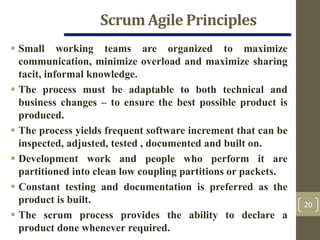1. The document discusses various agile development processes including Extreme Programming (XP), Scrum, Adaptive Software Development (ASD), and Dynamic Systems Development Method (DSDM).
2. It provides an overview of the key principles and activities in each process, such as planning, design, coding, and testing in XP, and speculation, collaboration, and learning phases in ASD.
3. Scrum uses an iterative process with sprints and daily stand-up meetings to frequently deliver working software increments for customer feedback, while DSDM employs feasibility and business studies prior to iterative functional modeling, design, and implementation cycles.




















